
 |
|
|
#61 |
|
(deceased)
Join Date: Dec 2004
Location: OKLAHOMA, USA
Posts: 3,138
|
SOMETIMES GRENADES BOMBS WERE THROWN DURING BOARDINGS SOME WERE IRON OUTSIDE, SOME WERE WOOD OR GOURDS WITH SCRAPNEL INSIDE AND SOMETIMES HAD WIRE WRAPPED ON THE OUTSIDE. ANOTHER TYPE WAS HEAVY GLASS AND PRODUCED SOME VERY BAD SCRAPNEL ANOTHER WAS A TYPE OF CHEMICAL GRENADE REFERRED TO AS A STINK POT. THE STINK POT WAS USUALLY THROWN BELOW DECKS OR INTO CABINS TO FORCE OUT THE OCCUPANTS. THEY WERE OFTEN MADE WITH BURNING SULPHUR, RARELY FIREBOMBS WERE USED BY PIRATES AS THEY DID NOT WANT TO BURN UP A SHIP BUT TO LOOT IT. GLASS BOTTLES WITH TURPENTINE OR KEROSCENE WITH A RAG FOR A WICK WAS THE USUAL FORM. SOME OF THE ARABIC GRENADE BOMBS WERE CERAMIC ON THE OUTSIDE WITH SCRAPNEL INSIDE.
|
|
|

|
|
|
#62 |
|
(deceased)
Join Date: Dec 2004
Location: Portugal
Posts: 9,694
|
This is ( again ) from a book i have on Piracy and Corso ( Privateers ):
... Contraband operations by the Dutch caused the evacuation of local French residents from the western Hispaniola, which contributed for the abandon of several domestic animals which, in wild conditions, reproduced abundantely. This has increased hunting activities. Wild bulls and pigs were then prepared the Caribean Indian way ( buccan ), which pleased passing by contrabandists, corsairs and pirates, both for its taste and also for its capacity to be stocked, due to its smoke treatment. This was the first reason for these guys being called buccaneers whom, gathering some wealth with the meat trade, became a threat to the people in the oriental part of the island. Quickly the hostilities started between both sides and, within time, most of these bucaneers quit their frequent wandering into the mountains, living in isolated straw huts, adopting piratic habits. As weaponry, they used at the belt three or four knives and a machete (cutlass ?) and a pouch with gunpowder and lead. Generaly they used a musket made in Dieppe, of large caliber and long barrel, shooting bullits of two ounces weight. They preferred gunpowder from Cheerburg, at the time known as the best quality, becoming named as bucaneer gunpowder. From what i understand, in a politic perspective they were not considered as "classic" pirates, but a disperse comunity of hunters and bandoleers ( bandits ), this not meaning they didn't worry the authorities. They lived as savages, regconizing nobody and accepting no leadership among therm, doing a thousand atrocities. Last edited by fernando; 16th January 2008 at 01:22 AM. |
|
|

|
|
|
#63 |
|
(deceased)
Join Date: Dec 2004
Location: OKLAHOMA, USA
Posts: 3,138
|
ISLAMIC CERAMIC BOMB/ GRENADES, 10 TO 12 CENTURY SOME WERE NO DOUBT JUST FIRE BOMBS NON EXPLOSIVE BUT WERE CHANGED WHEN GUNPOWDER BECAME AVAILABLE. i DON'T KNOW IF PIRATES EVER USED THEM BUT THEY MAY HAVE.
|
|
|

|
|
|
#64 |
|
Vikingsword Staff
Join Date: Nov 2004
Posts: 6,376
|
Great picture of the Indian smoking process Fernando .
Pity the poor Grenadier Barry; I'll bet those things killed as many throwers as receivers .   
|
|
|

|
|
|
#65 |
|
Member
Join Date: May 2006
Posts: 7,085
|
From memory, Oxford defines 'machete' as a cutlass.
|
|
|

|
|
|
#66 |
|
(deceased)
Join Date: Dec 2004
Location: OKLAHOMA, USA
Posts: 3,138
|
IT IS SAID RIFLES OR MUSKETS WERE FIRST CHOICE WHEN CLOSING IN BY PIRATES AND PISTOLS SECOND THEN THE SWORD OR AX. DURING THE TAKING OF A SHIP ANY SANE PIRATE WOULD PREFER TO SHOOT DOWN HIS ENEMY FROM A DISTANCE OR PERHAPS STAB HIM IN THE BACK THAN TO FACE HIM IN A SWORD FIGHT AS NOT ONLY COULD THE OTHER FELLOW BE A BETTER SWORDSMAN OR GET LUCKY BUT WHILE ENGAGED YOUR BACK WAS EXPOSED.
RIFLES AND PISTOLS WERE USUALLY LOADED WITH MORE THAN ONE BALL ,USUALLY ONE THAT FIT THE BARREL TIGHT AND PERHAPS 2 OR MORE THAT WERE A BIT SMALLER. THIS LESSENED THE CHANCE OF A NEAR MISS CONSIDERABLY AND ALSO ADDED TO THE KNOCKDOWN POWER OF THE WEAPON IF ALL STRUCK. I WILL TRY AND ADD SOME PICS OF SOME OF THE GUNS THAT MAY HAVE BEEN USED AND SOME STRANGE ONES AS WELL. THE RIFLE IS A SEASERVICE BROWN BESS CIRC. 1745, MADE SHORTER FOR SERVICE ON BRITISH SHIPS, THE PISTOL IS A SPANISH MIQUELET CIRC. LATE 16 TO EARLY 17 CENTURY. THE LAST IS A DUCKFOOT PISTOL ,ALL BARRELS FIRE AT ONCE SOME CAPTIANS CARRIED THEM AS THEY WORKED WELL AGAINST A MUTINY. |
|
|

|
|
|
#67 |
|
(deceased)
Join Date: Dec 2004
Location: OKLAHOMA, USA
Posts: 3,138
|
A FEW MORE GUNS FROM THE PERIOD THAT MAY HAVE SEEN USE BY PIRATES. 1. A BORDINGAX PISTOL GERMAN 1600'S, 2. A 1660 ENGLISH SMOOTHBORE FOWLING GUN (SMOOTH BORE GUNS WERE FAVORED BY BUCCANEERS), 3. 1717 FRENCH 69 CAL., 4. FRENCH TRADE GUN 1700'S, FRENCH MATCHLOCK 1690, 5. SPANISH 70 CAL. 1756.
THE PICTURES DID NOT COME OUT IN THE ORDER LISTED IN SORRY. |
|
|

|
|
|
#68 |
|
(deceased)
Join Date: Dec 2004
Location: OKLAHOMA, USA
Posts: 3,138
|
A FEW EDGED WEAPONS, ABOUT TIME EH?
 1. BOUCAN KNIVES OFTEN MADE FROM BROKEN WEAPONS WERE USED BY BUCANEERS. 2. CUTLASS, 1500'S TO 1700'S STYLE 3. CUTLASS OPEN BASKET 4.HANGER 5.SMALLSWORD 6.BOARDING AX CIRC. 1700'S SO FAR MY PIRATE POSTS HAVE MOSTLY COVERED WEAPONS FROM MORE RECENT TIMES AND OF EUROPEAN ORIGIN. THE FIRST MENTION OF PIRATES GOES BACK TO ANCIENT GREECE, ROME ECT AND NO DOUBT BEFORE WRITTEN LANGUAGE WAS INVENTED TO RECORD IT. AFTER ALL A GROUP ON ONE ISLAND OR CONTINENT MIGHT HAVE BEEN NOTED FOR PADDELING AND SAILING TO OTHER ISLANDS TO RAID AND PLUNDER SEASIDE VILLAGES BEFORE WRITING WAS AVAILABLE. THE VICTIMS OF SUCH ATTACKS WOULD HAVE HAD A TERM FOR THESE RAIDERS FROM THE SEA EVEN THEN. PIRATEING INCLUDED ATTACKS AT SEA AS WELL AS RAIDS ON LAND WHERE CONVIENT. SOME RAIDERS WERE CALLED BY OLDER NAMES BEFORE THE TERM PIRATE WAS COINED IF I REMEMBER IT CAME FROM A LATIN WORD USED DURING ROMAN TIMES. THESE PICTURES AND INFORMATION IS JUST THE TIP OF THE ICEBERG AS THERE HAVE BEEN SEA RAIDERS ALL OVER THE WORLD FOR A VERY LONG TIME. THERE WERE AFTER ALL OTHERS BESIDES (PIRATES OF THE CARRABEIAN) Last edited by VANDOO; 21st January 2008 at 01:55 AM. |
|
|

|
|
|
#69 |
|
Member
Join Date: Dec 2004
Location: Sint-Amandsberg (near Ghent, Belgium)
Posts: 830
|
This big knife would fit in quite nicely. I haven't a clue where it comes from. Just picked it up because it was cheap
  Total length is 41 cm 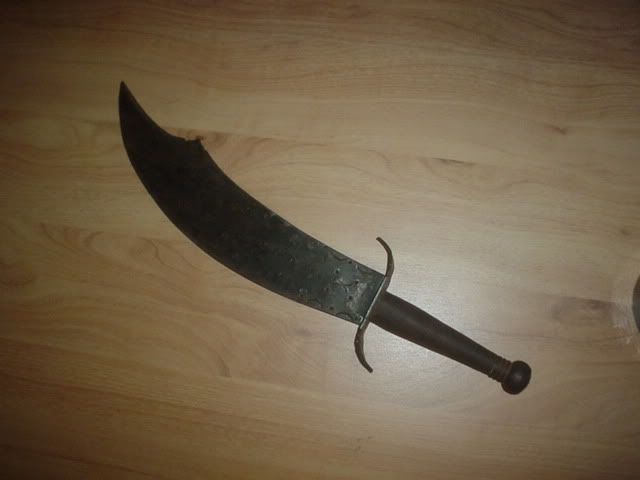 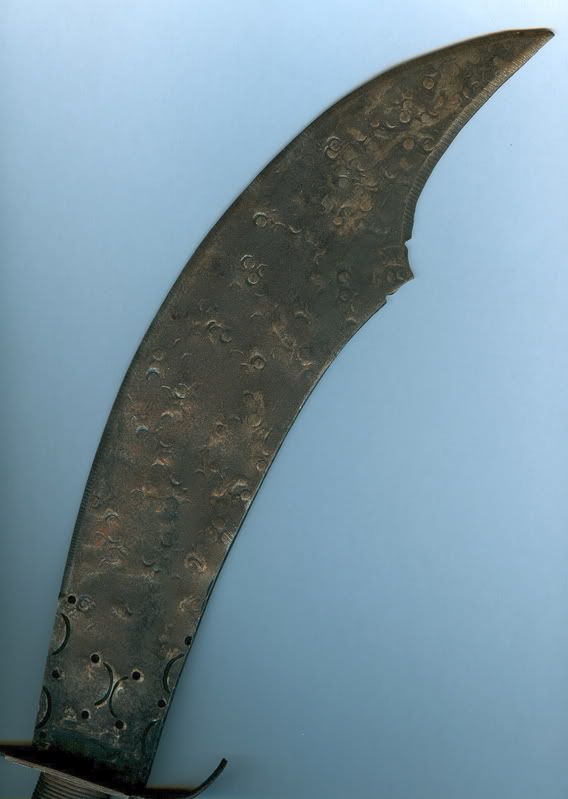 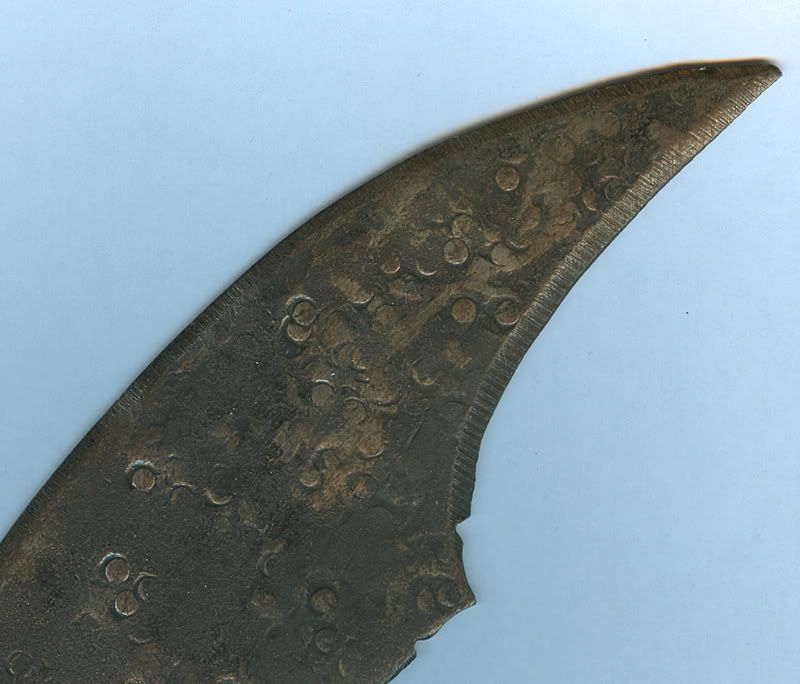 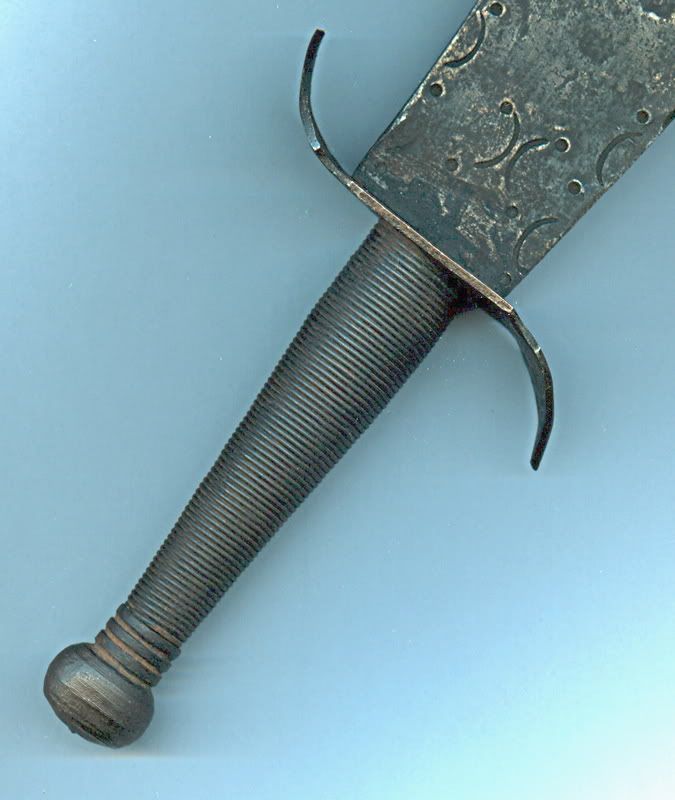
|
|
|

|
|
|
#70 | |
|
(deceased)
Join Date: Dec 2004
Location: Portugal
Posts: 9,694
|
Quote:
|
|
|
|

|
|
|
#71 |
|
(deceased)
Join Date: Dec 2004
Location: Portugal
Posts: 9,694
|
After the drawing of a hanger, here is a real one.
Indeed a handy sword to use abord ships, with a short but wide and thick blade. |
|
|

|
|
|
#72 |
|
Member
Join Date: Dec 2004
Location: NC, U.S.A.
Posts: 2,207
|
Hello folks,
I haven't posted in quite awhile (sorry, been busy!), but I stopped by, saw this thread and just couldn't leave it alone! I've been amassing a small collection of what could be called "pirate swords", boarding weapons and pieces that might have seen sea service for several years now (with what little funding I can manage). Being untechnological, I can't post pics, but I'd be happy to send some good ole-fashioned photos to one of the moderators to post if anyone is interested. Jim, we've discussed these weapons in the distant past (right before the 1st "Pirates of the Caribbean" movie, I recall) and I still have that Spanish Caribbean cutlass I sent you to look at. There's just something fascinating about pirates/privateers and the Age of Fighting Sail...  Mark |
|
|

|
|
|
#73 |
|
Arms Historian
Join Date: Dec 2004
Location: Route 66
Posts: 10,670
|
Avast Mark!!!!
 It has been a long time, and I do remember the great talks on the pirate theme! This thread has been a lof of fun, and actually I've been away from it a bit myself. Apparantly the guys have really added some pretty interesting entries here lately. It has been a long time, and I do remember the great talks on the pirate theme! This thread has been a lof of fun, and actually I've been away from it a bit myself. Apparantly the guys have really added some pretty interesting entries here lately.Very nice cutlass Fernando! Looks like a British hanger c.1750's with a pretty substantial blade mounted in it. Thanks for the historical material and perspective too. Vandoo, great stuff ! I'm beginning to wonder if you've traded in that war bonnet I always picture you wearing for a tricorn with jolly roger! Thank you for all the comprehensive material on pirate weapons, including the not often thought of grenades. I appreciate all the insight everybody has added on the terminology and etymology as well. Freddy, that scary 'Crocodile Dundee' lookin' piece seems likely to be a theatrical item made to resemble old Italian falchions from about 16th c. and even has had interpretations of the familiar Genoan 'sickle marks' added. Even if ya didn't use it, it might scare a guy to death  Thanks very much everybody for keeping this thread going. I always hope these threads will do just as this has, to serve as a sort of comprehensive reference resource for future research and giving us all better understanding of the subject. I know this thread has gotten me to rewatch the pirate classics over again, and looks like we've even hooked the old salt Mark Eley!!  Looking forward to those pictures Mark! Looking forward to those pictures Mark!All the best, Jim |
|
|

|
|
|
#74 |
|
Member
Join Date: Dec 2004
Location: NC, U.S.A.
Posts: 2,207
|
Thanks, Jim. Good to be back. I have also thoroughly enjoyed this thread, the general discussion and pics sent in. There are many books on pirates/privateers out there, but I find the best one that covers the entire pirate tradition from ancient times to present and in all cultures is "Pirates- Terror on the High Seas from the Caribbean to the South China Sea", JG Press. You mentioned pirate movies and I had a vague recollection of the original Disney classic Swiss Family Robinson and their encounter with the Indonesian pirates. Great old flick! Anyway, I'll send the pictures soon...
|
|
|

|
|
|
#75 |
|
Member
Join Date: Mar 2006
Location: Room 101, Glos. UK
Posts: 4,259
|
in the past i've seen a number of UK fire axes passed off by vendors as 'boarding axes' yesterday there was an axe sold as a long handled fireaxe from a victorian fireboat. to me it looks more like a 19c UK boarding axe passed off as a fire axe. i bid on it justincase but was outbid. hope the buyer was looking for a boarding axe rather than the std. short handled fireaxe normally seen. this axe has a british broad arrow mark on the blade over an N, and a small brass numbered plate on the haft with a 'P' over a '48' (no 48 port?). thought i'd rescue a picture of it for the pirate thread, nothing like a good boarding axe to open up them locked boxes and doors while looting, and removing other obstacles, like victims.
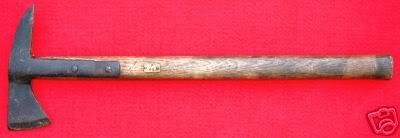 this may or may not be one, but looks typical of the breed. |
|
|

|
|
|
#76 |
|
(deceased)
Join Date: Dec 2004
Location: OKLAHOMA, USA
Posts: 3,138
|
AUXILLARY WEAPONS/ TOOLS, GRAPPELING HOOKS AND BELAYPIN. 1915 MORO TROOPER WITH ALARM GONG, NOTE THE CANNONS IN THE PICTURE. 1910 CHINESE PIRATES IN HONG KONG ABOUT TO GET SHORTENED BY A HEAD.
|
|
|

|
|
|
#77 |
|
Member
Join Date: Aug 2007
Location: CHRISTCHURCH NEW ZEALAND
Posts: 2,813
|
Known as LANTAKA cannon. A couple of pics of these at Fort Siloso, Singapore. Origin is Portuguese I believe and no doubt were used to either repel boaders or to clear the decks of opposition during boarding.
Regards Stuart |
|
|

|
|
|
#78 | |
|
Member
Join Date: Aug 2007
Location: CHRISTCHURCH NEW ZEALAND
Posts: 2,813
|
Quote:

|
|
|
|

|
|
|
#79 |
|
Member
Join Date: Jun 2007
Location: Malaysia
Posts: 66
|
Malay Cannon of the 17th & 18th Century
Cannon such as these were being manufactured nearly one hundred years before the arrival of Europeans to this part of the world. It is believed that gun making was introduced to the region by Muslim traders from the Middle East. The cannon are smooth bore and muzzle loading. They were used as weapons of war and also signalled the start and end to fasts during the period of Ramadan. The firing of cannons was also used by royalty to announce a royal birth or wedding.   Sources : http://www.fortsiloso.com/museum/malay.htm |
|
|

|
|
|
#80 |
|
Member
Join Date: Jun 2007
Location: Malaysia
Posts: 66
|
|
|
|

|
|
|
#81 |
|
Member
Join Date: Feb 2008
Location: Edinburgh, Scotland
Posts: 48
|
Arrrr lads!
Regarding pirates, I may have discovered the whereabouts of the sword of the famous Barbarossa (aye, famous before he even starred in Pirates of the Caribbean!).....in Scotland. I`m saying no more until I can provide a photo and provenance, otherwise they`ll clap me in irons!! Macdonald |
|
|

|
|
|
#82 | ||
|
(deceased)
Join Date: Dec 2004
Location: Portugal
Posts: 9,694
|
Quote:
http://en.wikipedia.org/wiki/Lantaka I am not an expert, but aren't those suspension dolphins on some of the pictured models of Spanish/Portuguese influence? Quote:
These were auctioned in 1989 in Lisbon; the triple barreled one for a fortune. Fernando |
||
|
|

|
|
|
#83 |
|
(deceased)
Join Date: Dec 2004
Location: Portugal
Posts: 9,694
|
May we come to the conclusion that piracy allways existed, as actually it may still exists ... i mean classic pirates, not the sophisticated version ones
 . Weaponry used became therefore more and more modernized. . Weaponry used became therefore more and more modernized.The event depicted in the attached picture just took place "the other day". It appears that the China Sea, after the opium war, was boiling with shameless pirates, that assaulted civilian merchant junks, also imperial ones, even threatening westerners. Some guy called Mah Chow Wong was one of the mightiest, leading various fleets and with enough wealth to bribe whomever necessary. They wouldn't hesitate to atack territories under Portuguese protectorate, such as Macau. This gave place for local traders, fishermen and ship owners to ask the mandarins escort for their boats and guard to their businesses by Portuguese forces. By around 1855 a total of almost 200 Portuguese lorchas, handled by mixed Chinese and Portuguese crews, were hunting these pirates. Weapons then used were rifles, swords ( sabres ) and axes. |
|
|

|
|
|
#84 | |
|
Member
Join Date: Dec 2004
Location: Athens Greece
Posts: 479
|
Quote:
Check this |
|
|
|

|
|
|
#85 | |
|
Arms Historian
Join Date: Dec 2004
Location: Route 66
Posts: 10,670
|
Quote:
 and I'm really looking forward to hear more on your discovery. It is clear you have a keen knack for tracking incredibly important historical swords. and I'm really looking forward to hear more on your discovery. It is clear you have a keen knack for tracking incredibly important historical swords.Please tell us something soon OK....this kinda stuff keeps me up nights. Yannis......you're quite right, Barbarossa was in the Meditteranean, and these 'Barbary Pirates' really got around. Remember that there was considerable trading in the Meditteranean , from the Maghreb to Spain, England, France, Italy and there were was at least one Armada galleon wrecked in Scotland. Spain and Scotland were well established allies, and Bonnie Prince Charlie, was born in Rome, as the Royal House of Stuart was Catholic, by religion linking Spain, Italy, France and the Holy Roman Empire of Eastern Europe. I would not be the least but surprised with a Meditteranean sword found in Scotland, as I have seen an example of 'nimcha' also from the Maghreb being worn by an English noble painted in the 17th century. All best regards, Jim |
|
|
|

|
|
|
#86 |
|
Member
Join Date: Dec 2004
Location: Bay Area
Posts: 1,727
|
Considering the fleet size, wealth and overall achievements of Hayreddin Barbarossa, I cannot think of any other pirate in history that nearly comes close to him. Captain Morgan was promoted to governor of Jamaica? Well, Brabarossa had all of Algeria and Tunisia as a fiefdom. Considering that his fleet had more ships than his Catholic enemies combined, I would expect him to have possessed more than one sword, and I would expect his weapons to have been quite ostentatious and lavish in their decoration. I remember the portrait published in North's monograph on Islamic Arms, but I think this portrait is a century later than Barbarossa. I would expect a nimcha as far as the blade is concerned - something similar to the nimcha in Elgood's book on Arab arms, but I am not so sure about the hilt. The quillons and the hand protection typical of the Maghrebi seifs/nimchas perhaps came as a result exactly of Barbarossa's campaigns in the Western Mediterranean, as his men must have captured a large quantity of European swords and other weapons. We might perhaps even be treated to a sword of Genoese manufacture, a gift or trophy. I too am eager to see what one of Barbarossa's swords may have looked like.
|
|
|

|
|
|
#87 | |
|
Member
Join Date: Aug 2007
Location: CHRISTCHURCH NEW ZEALAND
Posts: 2,813
|
Quote:
|
|
|
|

|
|
|
#88 |
|
Member
Join Date: Jun 2007
Location: Malaysia
Posts: 66
|
Malay Firearms
Rifled Musket & Pistol # Pemuras (Malay Decorated Traditional Gun) # Bedil Istinggar (Malay Flintlock Musket) # Tarkul Malay Cannon # Lela Rentaka # Lela Rambang # Tahan # Lada Sicupak (Aceh Cannon) # Nang Liu-Liu (Patani Cannon) # Seri Patani (Patani Cannon) # Seri Negeri (Patani Cannon) # Badak Berendam (Kedah Cannon) Brunei Darul Salam Pemuras   Pemuras and Karga are royal regalia where the Pemuras is a large gun held against the right shoulder of the Panglima Raja wearing red ceremonial attire. While the Karga is the bullet carrier strapped on the left shoulder to the right side of the body. Aceh Darul Salam Pemuras    Makassar Pemuras 
|
|
|

|
|
|
#89 | |
|
Member
Join Date: Dec 2004
Location: Athens Greece
Posts: 479
|
"...Still in 1515 Oruç Reis sent precious gifts to the Ottoman Sultan Selim I who, in return, sent him two galleys and two swords embellished with diamonds...."
From Wikipedia Quote:
16th century contemporary painting, Louvre Museum, Paris. And yes Jim, a sword of him could be anywhere in Europe. But it will be extremely difficult to connect it with the person. |
|
|
|

|
|
|
#90 |
|
Member
Join Date: Feb 2008
Location: Edinburgh, Scotland
Posts: 48
|
That`s a great portrait, cheers for posting Yannis!
The sword is in private hands and it`s a matter of getting permission to view, handle, photograph and dcoument it. I shall keep ye all updated. Macdonald |
|
|

|
 |
|
|